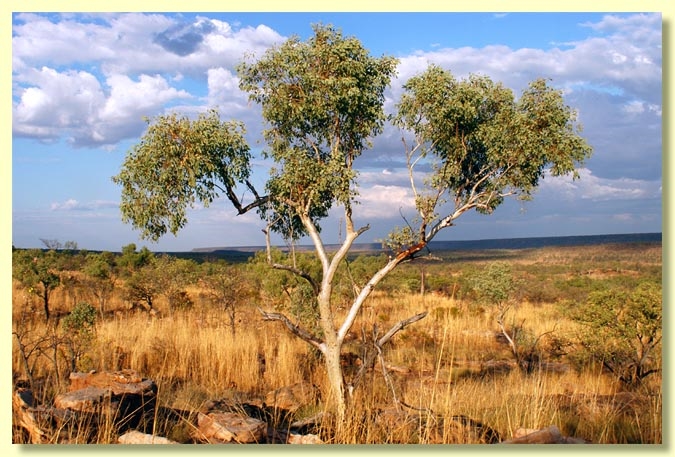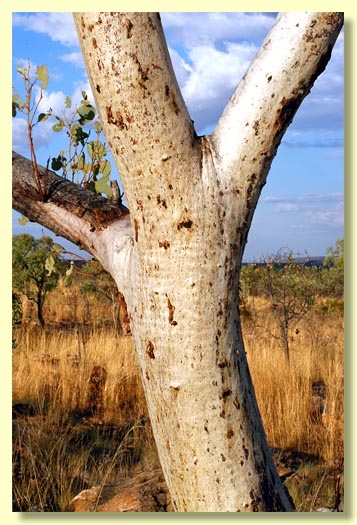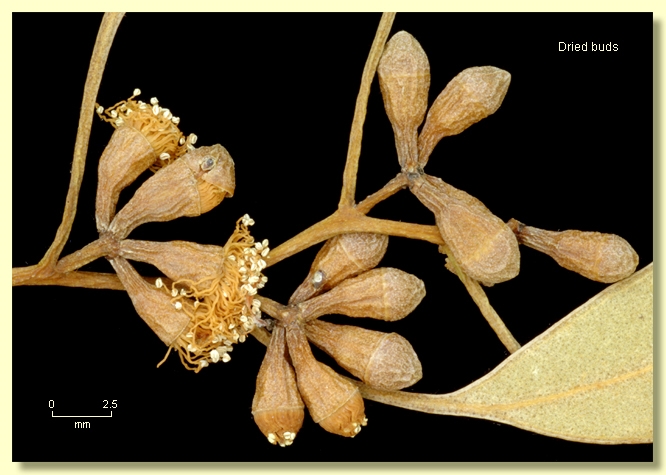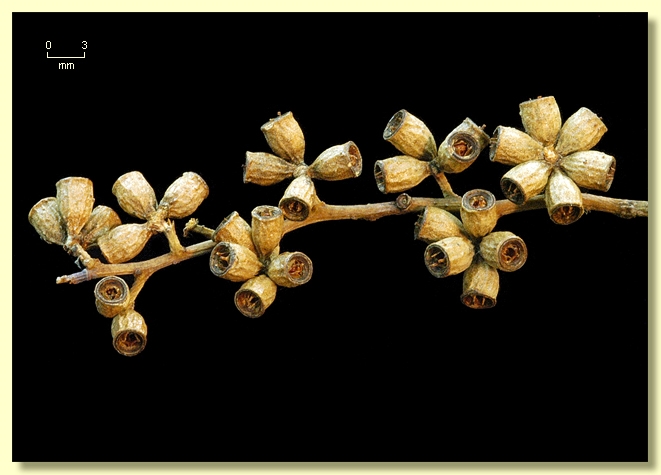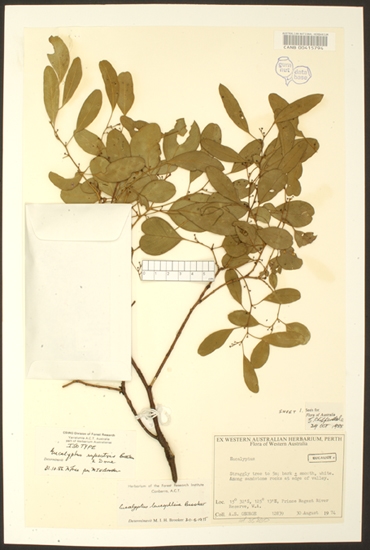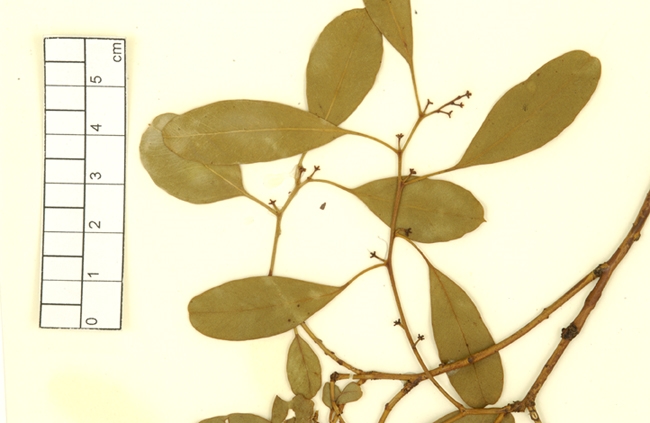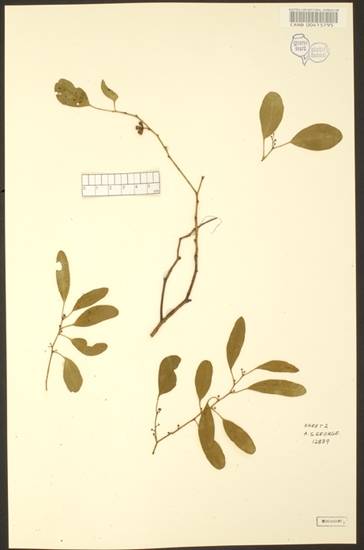Euclid - Online edition
Eucalyptus rupestris
Eucalyptus | Symphyomyrtus | Platysperma
Eucalyptus rupestris Brooker & Done, Nuytsia 5 (3) 385 (1986).
T: Prince Regent River Reserve, Western Australia, 15° 32’S 125° 13’E, 30 August 1974, A.S.George 12839; holo:PERTH; iso:CANB.
Tree to 5 m tall, occasionally slightly taller. Forming a lignotuber.
Bark smooth throughout, satiny except where recently shed then powdery, new bark pale orange, ageing to white and weathering to grey in patches.
Juvenile growth (coppice or field seedlings to 50 cm): stems square to round in cross-section, not glaucous; juvenile leaves always petiolate, alternate, orbicular to ovate, sometimes wider than long, (3.5)5–7 cm long, 3.5–8 cm wide, base rounded to tapering to the petiole but lowest leaves may be slightly lobed to truncate, grey-green to green.
Adult leaves alternate, petioles 0.8–1.8 cm long; blade elliptic to ovate to broadly lanceolate, 3.7–7.5 cm long, 1–2.5(3) cm wide, base tapering to petiole, margin entire, apex usually pointed, concolorous, dull green, side-veins at about 45° to the midrib, reticulation very dense, intramarginal vein present, oil glands apparently absent or obscure.
Inflorescence axillary unbranched, sometimes clustered near the ends of the branchlets, peduncles 0.3–0.5 cm long, buds per umbel 7, shortly pedicellate (pedicels c. 0.2 cm long). Mature buds obovoid to cylindrical, c. 0.4 cm long, 0.3 cm wide, scar present (outer operculum shedding early in bud development), operculum conical to rounded, stamens irregularly inflexed, anthers oblong, versatile, dorsifixed, dehiscing by longitudinal slits, style long and straight, stigma blunt, locules 3(4), the placentae each with 6 or more vertical rows of ovules. Flowers white.
Fruit sessile to shortly pedicellate (pedicels 0–0.2 cm long), cupular to more or less cylindrical, non-glaucous, 0.3–0.5 cm long, (0.2)0.3–0.4 cm wide, disc obliquely descending, valves 3(4), near the rim or slightly exserted.
Seeds brown to yellowy brown, 1–1.5 mm long, flattened-ovoid, dorsal surface shallowly reticulate, edge of seed smooth, hilum ventral.
Cultivated seedlings (measured at ca node 10): not seen
Flowering has been recorded in May.
A small tree, endemic to the Kimberley region of Western Australia, on sandstone ridges, pavements and escarpments of the Prince Regent River, Caroline Ranges, Mitchell River, Theda and Drysdale River National Park areas. Characterised by the smooth white powdery bark becoming satiny (non-powdery) late in dry season, the orbicular juvenile leaves, dull, relatively small, elliptical to broadly lanceolate adult leaves and small cupular-cylindrical fruit with a narrow descending disc.
Eucalyptus rupestris belongs in a group of species that are distinguished by having smooth bark, very dense reticulation in the adult leaves and flat, flattened-ovoid, pale yellow-brown to brown seeds with a non-toothed margin and a ventral hilum. The other members of this group are E. kenneallyi, E. umbrawarrensis, E. leucophloia, E. confluens, E. brevifolia and E. ordiana.
Within this group, E. rupestris is close to E. kenneallyi and E. umbrawarrensis. It is distinguished from E. kenneallyi by having shorter and broader adult leaves, usually elliptical to ovate to broadly lanceolate in E. rupestris and lanceolate to narrowly lanceolate in E. kenneallyi. It can be easily separated from E. umbrawarrensis by its dull, ovate to broadly lanceolate adult leaves and orbicular juvenile leaves (E. umbrawarrensis with glossy, lanceolate adult leaves and ovate juvenile leaves and is endemic to the Northern Territory). It is also very close to E. leucophloia and is distinguished by its small, cylindrical to cupular fruit and shorter peduncle (E. rupestris with fruit normally 0.4 cm or narrower and peduncle 0.5 cm or shorter, while E. leucophloia has hemispherical to cupular fruit normally 0.4 cm or wider and peduncle 0.5 cm or longer). Both E. brevifolia and E. confluens can be distinguished by their broad flat to slightly ascending disc of the fruit (E. rupestris with a narrow descending disc) and E. confluens can be further separated by having glossy adult leaves (dull in E. rupestris). E. ordiana differs by retaining its broad juvenile foliage through to the mature crown (E. ordiana with mature crown leaves greater than 3 cm wide and E. rupestris with mature crown leaves normally narrower in width than 2.5 cm).
Within its area of occurrence, E. rupestris maybe confused with other closely related white gums, i.e. E. alba var. australasica, E. apodophylla, E. cupularis, E. herbertiana, E. houseana, E. mooreana and E. pantoleuca. It can be easily separated from all these by its adult leaf shape and dimensions. The adult leaves of E. rupestris are relatively small, normally elliptical to ovate and no longer than 7.5 cm and no wider than 2.5 cm and have slender petioles. E. alba var. australasica has relatively large, broadly lanceolate to ovate leaves, normally longer than 8 cm and wider than 2.5 cm. E. apodophylla has large, opposite, elliptical to ovate to broadly lanceolate adult leaves, normally longer than 7 cm and wider than 3 cm. E. cupularis, E. herbertiana and E. houseana all have relatively long lanceolate adult leaves, normally longer than 8 cm. E. mooreana has large elliptical to ovate adult leaves, normally wider than 3.5 cm and E. pantoleuca has large opposite, orbicular to deltoid adult leaves, normally longer than 9 cm and wider than 7 cm.
Eucalyptus rupestris: Latin rupes, rock and estris, indicates place of growth , referring to the rocky situation in which this species has always been found.

